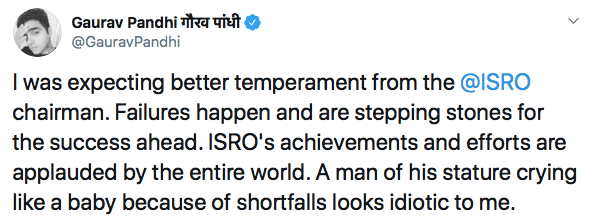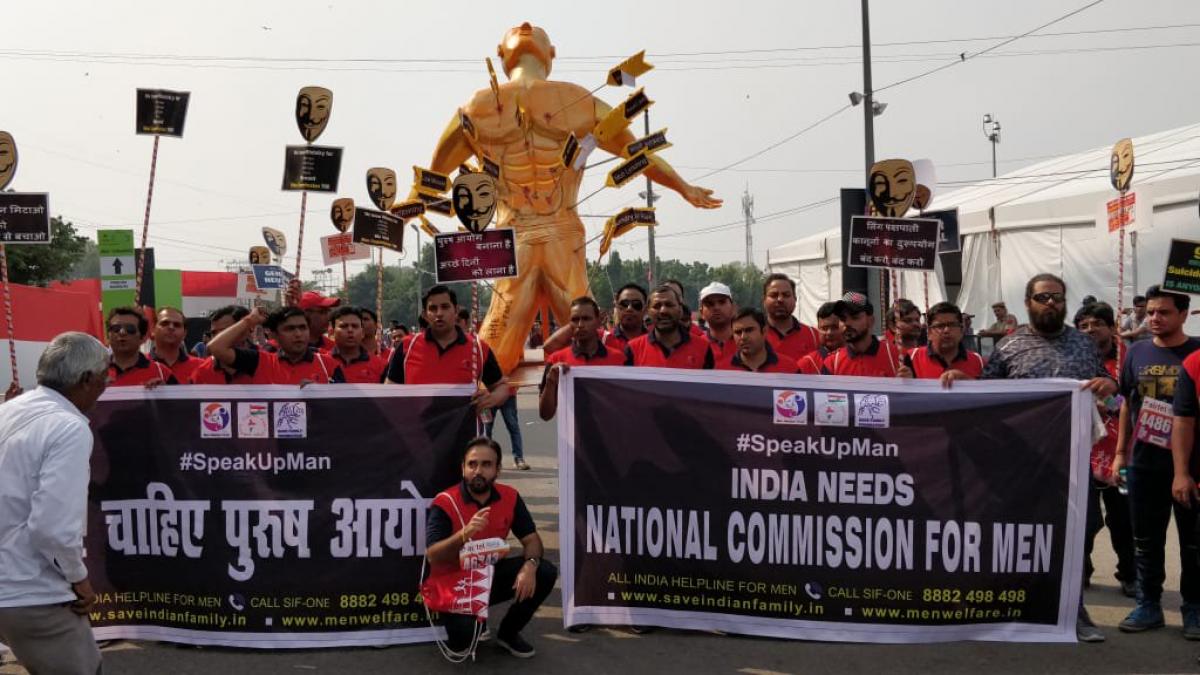In the last two weeks, we’ve seen Good Morning America’s host Lara Spencer ridicule Prince George for his special love of ballet among the other subjects he’s pursuing outside of school. In a more local context, we’ve seen the public criticize ISRO Chairperson K Sivan for crying when Chandrayaan-2’s Vikram Lander failed to touch down on the Moon’s surface.
Among all of this highly visible public discourse, what message are we sending to young men about what is and is not acceptable? Is it the message we want to be sending as we strive toward a more gender equitable world?
Biologically speaking, baby boys and baby girls are “programmed” to cry equally. They cry the same amount at birth or for the first five years of their life.
When we take away yet another tool that boys have to express themselves in a productive and peaceful manner, we are again reinforcing the norms of toxic masculinity, right from childhood.
So why do we see so many fewer representations of men crying in movies and the media? According to Tony Porter, “…around age 5, boys get the message that anger is acceptable but that they’re not supposed to show other feelings, like vulnerability.” In other words, this expectation is 100% constructed by society.
And it has not helped when esteemed political analysts like Gaurav Pandhi perpetuate this norm vocally and visibly. When you’ve put your blood, sweat, and tears into something that’s been in the works since 2007 — or you see your lander spacecraft lose communication with ground stations just 2.4 kilometers before touching down on the Moon’s surface—crying is a completely natural human response.

I’m wondering: what would we have wanted to see? Would we have been more comfortable if Mr. K Sivan had responded to the failed landing with a gruff handshake and brief statement? Space exploration is resource-intensive, time-intensive, and passion-intensive. Probing the edges of the known universe is about as earth-shattering as it gets. You don’t enter the field if you’re not passionate about the galaxy’s possibilities. So when the world looks forward to a mission you are in charge of, and it does not culminate in the outcome you were hoping for, it can become a lot of pressure, at the least — and more likely, heartbreaking.
Also read: Mard Ko Dard Kyon Nahin Hota?— On Hegemonic Masculinity
The rough exteriors we’ve encouraged our boys to cultivate cover up a depth of pain that can go along with growing up as a boy. While society speaks openly about the obstacles that accompany girls’ success in school, family, and the workplace, we often have a blindspot when it comes to the burdens that are borne by boys growing up in a patriarchal society. And through conversations on topics like whether it is “okay” for men to cry, we give young men major signaling as they’re growing up that they should remain silent about their pain.
The rough exteriors we’ve encouraged our boys to cultivate cover up a depth of pain that can go along with growing up as a boy.
This isn’t discussed enough. 53% of the sexual abuse incidents in India each year are crimes against boys. Boys are less likely to tell a family member about their experiences with abuse. Boys are 89% less likely than girls to reach out for psychiatric support after they have been victims of sexual violence. When the country is engaging in discourse debating whether a man’s reaction of genuine grief and disappointment was “okay,” it is unsurprising that many boys don’t reach out for help when they experience grief or depression.

Instead, they might rely on outlets like misbehaving in school or exaggerated visibility — what is actually in many cases a desperate cry for support. Boys who have been hurt rely, in some cases, on violence as a way to express their pain. When we remove outlets like open expression of emotion or creation of art from the toolkit that boys have to process their pain, we are seriously stunting their ability to live happy, fulfilled lives.
Also read: BOYS DON’T CRY: The gender guidelines and empowerment efforts
The next time we choose to pass comments about men showing their emotions in the public sphere, just like K Sivan, let’s think about the very real consequences of suppressing emotions for adolescents growing up surrounded by the rigid norms of a patriarchal society – what it means for our girls and women, and what it means for our nation’s boys.
Featured Image Source: India Times





i love my india
All humans have feelings that is natural
And it is normal to show it.
But we are Social animal too.
We have responsibility too
boys or male are biologically,mentally and Socially strong enough and capable to control the emotions and its good for them and society
They have to develop such thing
If they wanted to serve the family nation and future.
Its good for boy to be tough strong
Mens are biologically born for fight not cry.
Cry is for coward*
(but emotions are acceptable and natural too,but not always)
girls accepted to cry.(but similar conditions too apply for her in some sense.)
It was a upset mission
It is this very thing we need to instill in our boys so they grow up to be more caring and understanding, cry if they want, and speak up without feeling guilt or shame for something which isn’t even their fault. I think it will not only improve the way our society views sexual violence against men, but women as well. And why just limit it to sexual violence? Domestic and family life would improve greatly if men start looking at women and children with empathy as well.